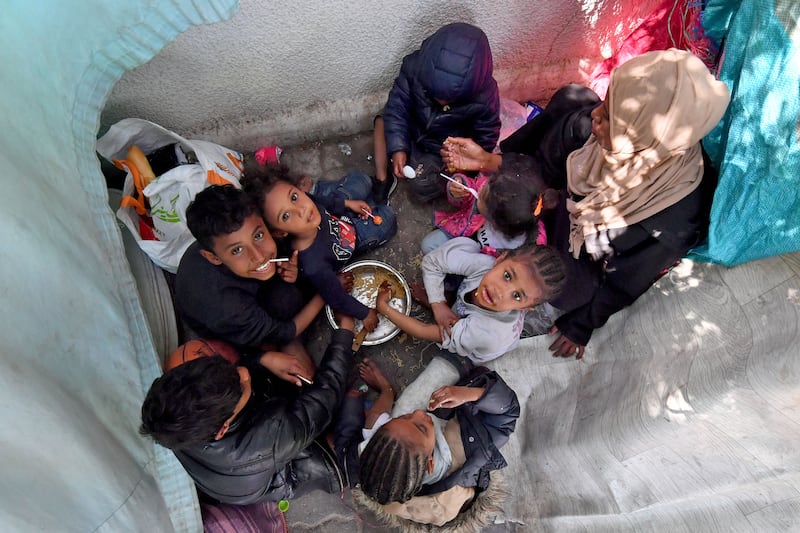Saad Eddin Ismail left his home in Darfur, Sudan, six years ago, on a long quest to find safety.
The 27-year-old comes from Geneina, a city in West Darfur. He remembers violence breaking out in 2003, in what was described as the first genocide of the 21st century. Afterwards, the violence never fully stopped. “We have too many problems in Darfur... The solution [is] only to go outside of Sudan.”
He travelled to Chad, then Libya, where he tried to cross the sea towards Europe five times. Each time he was caught. Since 2017, the EU has been supporting the Libyan coastguard to intercept boats of refugees and migrants, with more than 122,000 caught on the Mediterranean Sea since then and forced back to Libya. There, they are often locked up indefinitely in detention centres that have been described as concentration camps by Pope Francis, among others.
“I don’t know what’s going on, Sudan is not safe and also the sea is not good,” Ismail says. He eventually walked across the border to Tunisia in 2019.
READ MORE
I need a solution. All these people, we need a solution. They say Tunisia is safe, it’s democratic, but Tunisia is not safe, it is not democratic... Things are very difficult, especially with this new president
— Saad Eddin Ismail
Ismail has been registered with the United Nations Refugee Agency (UNHCR) since then. “But I do not see anything. The privileges, rights and duties are zero in Tunisia. The [1951 Refugee] Convention has not been implemented in Tunisia. Where is the protection, where is the health, where is education? They do not have any solutions. They only say if there is something [happening] they’ll call me.” He says he has been “waiting” for four years.

Last year, Ismail participated in a months-long protest in front of the UNHCR office, during which hundreds of refugees called for evacuation from Tunisia “to any country that respects human rights”, he explains. Last December, he says he was told that he is now among a tiny minority: refugees being considered for resettlement in the US. Since then there has been no further progress.
“I need a solution. All these people, we need a solution. They say Tunisia is safe, it’s democratic, but Tunisia is not safe, it is not democratic... Things are very difficult, especially with this new president.”
In February, Tunisian president Kais Saied unleashed a wave of repression and abuse against black Africans in Tunisia after he accused them of being part of a “criminal plot” to change the demographics of the country. Since then, many interviewed by The Irish Times say they have been fired from jobs or evicted from accommodation, which played a part in increasing the numbers of people trying to cross the Mediterranean Sea to reach Europe.
‘No sleep’
Today, Ismail lives in a shelter down a side road in a suburb of Tunisian capital Tunis, with more than 100 other refugees and asylum seekers, including Eritreans, Somalis, Sudanese and stateless people. At night, he rests in a bare room with beds for seven people, many of whom suffer from severe trauma or anxiety. “Everyone is confused. There is no sleep. Sleep does not come.”
Ismail’s experience shows that the so-called legal routes to safety can bring their own form of psychological torture, with lengthy uncertainty and a far from guaranteed outcome. He knows of at least two people from the shelter who have died trying to cross the Mediterranean Sea, even though they were being considered for resettlement. Others have returned to Libya, despite the ongoing human rights abuses and extortion there.
The UN has described the Central Mediterranean route – between Libya or Tunisia and Italy or Malta – as the deadliest migration route in the world. More than 22,300 people have died or gone missing trying to cross it to Europe since 2014, more than 2,065 of them this year.

In comparison, between 2021 and August 2023, a UNHCR spokesperson said that just 146 refugees were legally resettled from Tunisia, 40 of whom went to the US. The spokesperson said that they were aware that some others, including those living in UNHCR shelters who had been submitted for resettlement, gave up on the process and left Tunisia through other means this year.
[ Italian island Lampedusa declares emergency as 7,000 migrants arrive in 48 hoursOpens in new window ]
A UNHCR spokesperson said: “Refugee resettlement quotas are put forward by states and given the very limited availability of resettlement places worldwide, it is not a solution for all refugees but a tool of life-saving protection for those most vulnerable and at heightened risk in countries of asylum. Less than 1 per cent of refugees are resettled each year (out of a global refugee population of 21.3 million refugees under UNHCR’s mandate, only 57,500 refugees were able to be resettled in 2021).”
The processing time varies “depending on the individual case and the resettlement country,” the spokesperson said. “Final decisions with regards to resettlement are taken by the receiving countries and not UNHCR.”

Tunisia – with a population of roughly 12 million – is a migration hotspot and now the top departure point for people trying to reach Europe by sea. Those gathered there have travelled from across Africa and sometimes the Middle East, escaping wars, dictatorships, droughts and crushing poverty. Most are likely not registered with UNHCR. The UNHCR spokesperson said 3,473 refugees and 6,331 asylum seekers from more than 40 nationalities are registered with them in Tunisia. Of these, 77 per cent are Syrian, 6 per cent Sudanese and 4 per cent Eritrean.
According to data collected by the Migration Policy Institute think tank, the numbers of refugees resettled to the US plummeted from nearly 85,000 in 2016, to lfewer than 12,000 in 2020 and 2021 – the lowest in the programme’s history
Asylum seekers and refugees registered with UNHCR receive a card to attest their status in the country, the spokesperson said. “These procedures aim to protect persons seeking international protection from arbitrary arrest, detention, and refoulement [being forcibly returned to the country from which they had fled].”
Access to humanitarian assistance “is provided to individuals and families at heightened risk, including shelter, food, and cash assistance,” the spokesperson said. The agency is involved in the management of five “safe shelters” in Tunisia, where residents have “access to psychosocial support, food assistance, and support to enrol children in school, among others.”

US resettlement
While the US has traditionally been the country offering the largest amount of resettlement spots for refugees globally, numbers were drastically reduced under former president Donald Trump, and again affected by the Covid-19 pandemic. As a result, there is a huge backlog, according to the executive director of Refugee Council USA John Slocum, with many refugees waiting for five years or more to travel.
According to data collected by the Migration Policy Institute think tank, the number of refugees resettled to the US plummeted from nearly 85,000 in 2016, to fewer than 12,000 in 2020 and 2021 – the lowest in the programme’s history. Last year, 25,465 refugees were resettled – much fewer than the allocated 125,000 spaces. By the end of May this year, 31,797 refugees had been resettled.
The resettlement process begins with a referral from UNHCR or another NGO, or sometimes directly from a US embassy abroad to the US refugee admissions programme, he explained. Then the US state department reviews applications before the case is processed overseas at a resettlement support centre.
There is pre-screening, the preparation of case files and initial security checks, medical checks, cultural orientation and finally travel. Multiple US departments are involved in the process, he said.
The probability of someone actually travelling, compared to the numbers who begin the process, “almost certainly varies considerably from region to region, and as do process times. The time it takes varies considerably,” added Slocum. Typically, it might take between 1½ and three years.
“The Biden administration has made significant efforts in general to try to make overseas refugee processing more efficient,” he said. But next year, depending on who is voted into power in the US presidential election, that progress could be reversed again.

Meanwhile – even as the EU does costly deals with authoritarian regimes aimed at stemming irregular migration, many EU states have been reducing their refugee resettlement programmes because of “scarce reception facilities and political deprioritisation”, according to a new appeal signed by dozens of non-governmental and humanitarian organisations. They included the Irish Refugee Council, the International Rescue Committee and Amnesty International, who called for the number of spaces offered to be increased. “It is clear that Europe can and must do more to support people in need of protection and show solidarity with countries hosting the vast majority of displaced persons,” the appeal says.
While EU member states pledged to resettle more than 20,000 refugees last year, they admitted 16,695. “Resettlement and other complementary pathways to protection offer a lifeline to people forced to flee – a way to reach safety without endangering their lives,” the organisations said in the appeal. By September 15th, EU countries were due to submit new pledges related to how many refugees they will resettle for the next two years.
‘Just waiting’
In Tunisia, Ismail said that each day feels the same: “just waiting.”
“Now I only see the solution at sea,” he says. “The problem is only money.” A place in a boat could cost 3,000 Tunisian dinars (€900) – funding he doesn’t have. He has a UNHCR card and receives 200 dinars (€59) each month, but the money is spent on food and other expenses. It is hard for refugees in Tunisia to work legally.
He heard from a friend that his mother might be in a refugee camp in northern Chad now. ‘Maybe it’s safe, [maybe] it’s not safe’
Ismail says he would like to study and improve his education, but it is not possible without a passport. “My dream, I want to learn ... languages: English, French, Japanese, Russian, Italian, and maybe German.” He already speaks Arabic and Masalit, and he is practising English through the language learning app Duolingo, though it can be hard to stay motivated.

Ismail is unable to contact his family due to the war in Sudan and the lack of phone connection. “It’s not safe, so they’re moving around,” he says. He heard from a friend that his mother might be in a refugee camp in northern Chad now. “Maybe it’s safe, [maybe] it’s not safe.” His father died in 2003.
Sitting in the bare room in Tunis, in a country that is increasingly hostile to people who look like him, Ismail wonders when his life will finally begin.
“We want an evacuation to any country that respects humanity,” he said. “And we want to live with dignity like every human being.”






















